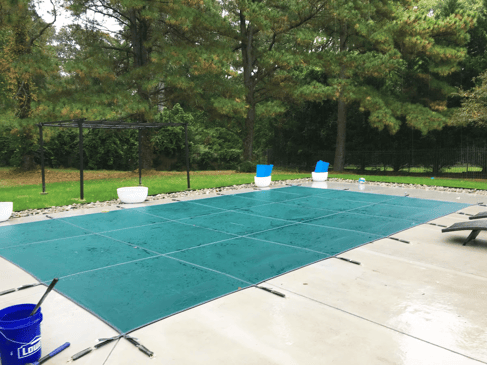If you’re new to the world of pool ownership, get ready to use your Surprised Face… You don’t have to have a pool cover. I always got the impression that you did, but it’s actually not required. The obligatory fence around the pool area is your first line of defense in the safety arena.
But like nachos and space heaters, pool covers are a good idea even if they’re not legally required.
Some people opt out of a pool cover completely because they don’t see the need for one and/or don’t want to spend the extra money.
We get that. Still, we recommend using a pool cover for two main reasons:
- An extra level of safety
- Keeping debris out
And, well, some people just run late getting a pool cover. I can’t judge procrastinators. Glass houses, stones, etc.
So how long can you procrastinate? Well, pretty long actually. You can install a pool cover at any time of year. However, we suggest you do it ASAP, or at least before or around the time you close your pool.
Pool cover types
The point: Get a pool cover. Better late than never! (Very late, in some cases.)
You may already have a cover type in mind. If not, no worries! Here’s a super quick refresher on your options.
There are three main types of pool covers.
- Tarp cover (the most basic)
- Security/safety cover
- Automatic cover
Side note: You may also hear about a solar cover. It helps keep your pool warmer during swim season, but it’s not a winter cover. You don’t use it during the off season.
Honestly, we don’t recommend tarp covers.
Most often we hear of folks getting a security cover. Those come as either a mesh material or solid vinyl.
Pool covers in snowy areas
Do you live in a chillier climate with glittery white snowfall in the winter? Maybe you like it; maybe you think of it as Inconvenience Powder. I find it lovely, but not every pool cover does.
Keep in mind that an automatic cover isn’t designed to take a huge snow load. We recommend you open up the cover if you’ll be getting 8-12 inches or more so it doesn’t damage the cover.
Some people even buy an automatic cover and, for the winter, put a security cover on top of it.
The snow will raise the water level by a little bit, but it’s okay. None of that water can get in to freeze the pipes.
Snow (and rain) won’t mess up the pump/filter system because you’ll have blown out and plugged the plumbing lines when you closed the pool. They’re safe regardless of how much water/snow is in the pool.
When should I install the pool cover?
For once, procrastination doesn’t ruin anything. You can install a cover anytime, even after winterizing.
Most people install their covers in September or October, when most pools in our region close.

Here’s the big thing: if you have a lot of tree cover, we recommend you install (and use) your cover before the leaves fall. Otherwise you’ll have to scoop all the leaves out of the pool, which takes hours. Actual hours. I wish I were kidding.
And you can’t just pretend you didn’t see the leaves and leave them in the water over the winter. Well, you can, but you’ll hate yourself for it. They’ll stain your pool. No thanks.
Long story short: just install your pool cover. Even if you’re a little late, it’s better than never doing it at all. In the long term, your pool will thank you.
Want more info about pools?
River Pools specializes in inground fiberglass pools.
Browse our catalog of models today and view our gallery to get inspired for your pool project.
Wondering how much a fiberglass pool might cost? Try out our pool pricing calculator or contact an independent installer in your area for a custom quote.
If you’d like to learn more about the different types of inground pools, download our free comprehensive ebook below. It discusses cost, design, surface durability, installation, and other important aspects that you may want to compare when shopping around for an inground pool.

Up Next:
How Does Pool Chlorine Work?
When Should I Close My Pool for the Winter?
How to Choose a Pet-Friendly Pool
Editor's note: This blog article was updated on October 17, 2018.
Editor's note: This article was updated on January 19, 2024.




